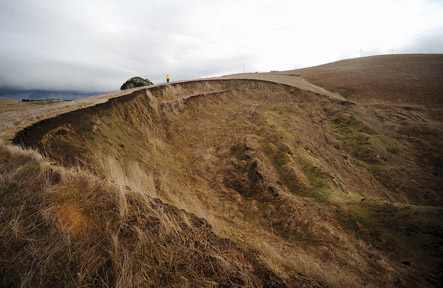
Plan to alternate water level may stop seepage
The News to You
Already closed to recreational use for nearly three years
because of the invasive zebra mussel, the San Justo Reservoir is
now dealing with landslides caused by seepage from the agricultural
water storage facility into nearby hillsides. The San Benito County
Water District believes a plan to alternate the amount of water
stored there throughout the year will address the problem and also
leave more room for storage.
The slow seepage of water from the San Justo Reservoir off Union
Road has saturated the soil on its perimeter and caused
landslides
that the San Benito County Water District hopes to curtail by
modifying the amount of water stored there.
”
In the beginning years after the reservoir was built (in 1987)
the landslides weren’t as much of a problem,
”
said Jeff Cattaneo, director of the water district.
Plan to alternate water level may stop seepage
The News to You
Already closed to recreational use for nearly three years because of the invasive zebra mussel, the San Justo Reservoir is now dealing with landslides caused by seepage from the agricultural water storage facility into nearby hillsides. The San Benito County Water District believes a plan to alternate the amount of water stored there throughout the year will address the problem and also leave more room for storage.
The slow seepage of water from the San Justo Reservoir off Union Road has saturated the soil on its perimeter and caused landslides
that the San Benito County Water District hopes to curtail by modifying the amount of water stored there.
“In the beginning years after the reservoir was built (in 1987) the landslides weren’t as much of a problem,”said Jeff Cattaneo, director of the water district.
“When it was built they identified those areas and put liner in to minimize the amount of water that would seep out. Once the reservoir was filled, they recognized seepage was greater than anticipated and landslides developed from water saturating the soil.”
Until three to four years ago, he noted, the landslides were “increasing in size and severity” until extra liner was added and return wells were installed to “de-water” the hillsides to slow the intrusion of water.
At that time, the Bureau of Reclamation required that the water district lower the surface elevation of water in the reservoir to 485 feet from 500 feet to slow the amount of seepage.
“It has been fairly effective at reducing the landslide issues,” Cattaneo said. “We believe that part of the problem is that the reservoir was held at the 500-foot mark for so many years – it was almost always full – that it created an equilibrium where water in the soil was very high, which exacerbated the slide issues.”
Instead of spending the estimated $3 million to $10 million it would take to repair the reservoir, the district recently hired a consultant to develop a plan to alternate the water storage throughout the year in an effort to moderate the seepage of water.
“We’re proposing to Reclamation, in an effort to regain the 2,600-acre-feet of water that we lost (by reducing the maximum capacity), that we return to operating it much like we did in the early years: filling it early in the season to maximize storage for agricultural deliveries, then draw it back down to 485 feet and below during the growing season,” Cattaneo said. “Then we’d raise it back up in the winter period just before the growing season starts again.”
He said the state has “been receptive to that proposal,” which will include studies and additional monitoring to ensure its effectiveness. The cost of that plan is expected to approach $750,000.
“We’re optimistic the reservoir re-operation plan will return most of the utility of the reservoir to us and return 2,600 acre-feet of volume.”
There are no structural issues that might impact the integrity of the reservoir itself, Cattaneo said, noting that “it’s more of a nuisance than anything else.” The Bureau of Reclamation purchased a portion of private property adjacent to the reservoir where landslides were a particular problem.
The district hopes to gain approval for the revised water storage plan by January so it can fill the reservoir to capacity this year.
“We still will have the same amount of water to work with, but it allows us to have our supply last longer if there were to be an interruption in the delivery from San Luis Reservoir,” Cattaneo said.
In years when the district has extra water, the additional local capacity would mean that the water could be stored in San Justo, rather than San Luis, where there is less of a guarantee that the additional supply could be held over year-to-year.
Closure still in effect
San Justo Reservoir remains closed to the public, nearly three years after invasive zebra mussels were discovered at the popular fishing and boating spot. Cattaneo said the closure will extend into 2012 as the district continues to work with state officials on a plan to eradicate the fingernail-sized creatures, which are harmful to water systems because they produce toxins that kill native organisms and reproduce so quickly and in such great numbers that they can clog irrigation delivery systems.









